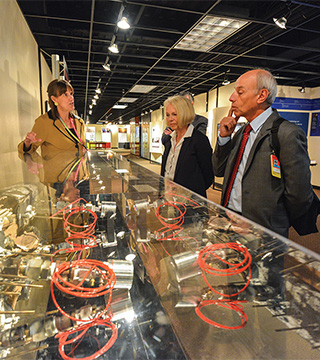
Anne Harrington, NNSA’s deputy administrator for Defense Nuclear Nonproliferation, addresses the media during welcoming ceremonies for the 25th International Training Course on the Physical Protection of Nuclear Material and Nuclear Facilities. Looking on are Sandia Labs Director Paul Hommert, left, and Denis Flory, deputy director general of the International Atomic Energy Agency and head of the agency’s Department of Nuclear Safety and Security. (Photo by Randy Montoya)
Sandia is playing host to 44 nuclear security students from 36 nations, who will return to their home countries well-versed in the latest techniques and technologies needed to protect nuclear materials.
Top officials from Sandia, NNSA, and the International Atomic Energy Agency (IAEA) welcomed the students to the 25th International Training Course (ITC) on the Physical Protection of Nuclear Material and Nuclear Facilities.
“Threats to nuclear materials and facilities often seem very abstract, but in this course we provide practical training that equips participants to implement the highest standards of nuclear security,” Anne Harrington, NNSA deputy administrator for Defense Nuclear Nonproliferation, said at an April 20 news conference on the opening day of the course.
Every 18 months for the past 37 years, Sandia has hosted the ITC, and so far has trained more than 800 people from 73 countries. This year’s course will conclude May 8.
Denis Flory, deputy director general and head of the IAEA Department of Nuclear Safety and Security, said the course is one of the most respected in the world. “It enables partnerships to initiate and operate proper physical security in their respective countries — in line with global regulations and recommendations — and to take part in a global effort to strengthen nuclear securities,” he said.
When Congress passed the Nuclear Non-Proliferation Act in 1978, it directed DOE to provide training in physical security techniques and technology to security specialists from the now 164 states that are members of the IAEA. DOE selected Sandia to fulfill the directive.
“This course showcases the unique partnership we have had for 37 years. Sandia offers the very best expertise in world in this subject,” said Harrington.
Harrington said the hands-on approach by instructors and practitioners in the field not only provides technical experience the students may not have, but helps to build connections between members in the program.
“[Sandia and our partners] are long-standing practitioners in the research, development, implementation, and refurbishment of physical security systems,” said Div. 6000 VP Jill Hruby, who was joined at the event
by Sandia President and Laboratories Director Paul Hommert. “Our collective goal in providing this course is to assist member states in the protection of nuclear materials across the life cycle, to include use, production, storage, transportation, and disposition.”
“Through this program, Sandia supports the NNSA and the IAEA so, together, we can achieve a goal we all share” in the physical protection of nuclear materials and facilities, Paul said.
Course has evolved over time
Since its inception, the course has evolved to reflect industry best practices and up-to-date physical protection technologies. The original guidelines for IAEA member states to use in establishing, implementing, and maintaining their national nuclear security regime was published in June 1977, Harrington noted.
“We now live in a world that changes at an astonishing speed compared to 1978. So, very appropriately, the guidelines that we apply to physical protection must change with the times as well,” she said.
The guidelines now offer a graded approach to protection, taking into account the assessed threat and potential consequences related to physical protection, and incorporating cybersecurity guidance.
“It is important that we not lose sight of the fact that cyber threats affect our work as well. In fact, a cybersecurity incident could lead to the theft of nuclear material, a catastrophic sabotage of a nuclear facility, or the falsification of safeguards information,” Harrington said.
ITC training focuses on a systems engineering, performance-based approach to requirements definition, design, and evaluation for physical protection systems. Participants learn a methodology for designing and evaluating physical protection systems for nuclear facilities and materials that are effective against the threats of radiological sabotage and theft.
“A strong security culture can only be built if the most senior people in the management pyramid are fully committed and demonstrate that commitment in meaningful ways,” Harrington said. “From my perspective, working with the IAEA to conduct the ITC is one of the most important contributions that NNSA makes to promoting the highest standards of nuclear security."